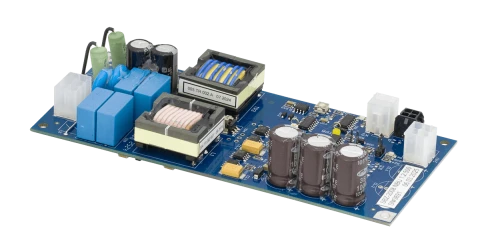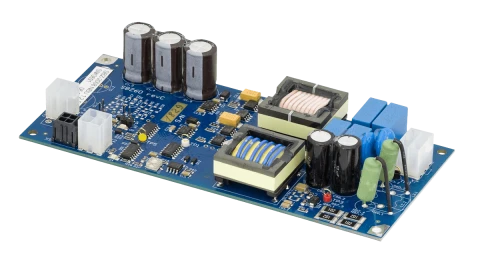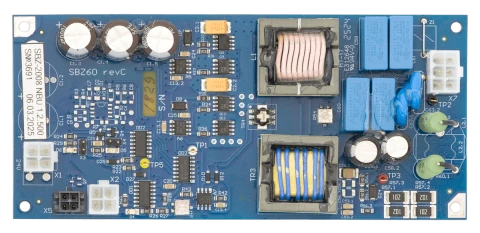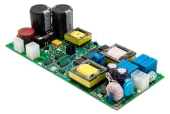Description
The SBZ-2008 simmer supply is a sophisticated device designed to enhance the performance and longevity of flashlamps by maintaining a low-current discharge. This capability is crucial for ensuring the stability and extended operational life of the lamp, making it a valuable component in various laser systems. With its robust construction and reliable performance, the SBZ-2008 is an ideal choice for applications requiring consistent and efficient simmering of flashlamps.
Built to operate with a 24V DC input voltage, the SBZ-2008 delivers a maximum output voltage of 200V and a current of up to 800mA, which can be adjusted from 300 to 800 mA with on-board potentiometer. Its maximum output power reaches 70W, providing ample energy for demanding applications. In case of current interruption, automatic simmer ignition restrikes with approximately 3 Hz repetition rate until the discharge is restored.
Compact and lightweight, the SBZ-2008 measures 152x68x38 mm and weighs only 0.2 kg, making it easy to integrate into various setups without requiring extensive space or additional cooling systems. Its rugged design allows it to operate effectively in temperatures ranging from -20 to +45 °C, with storage capabilities extending from -40 to +85 °C. The device is also protected against short circuits and open circuits, ensuring safe and dependable operation under diverse conditions. With a humidity tolerance of up to 90% in non-condensing environments, the SBZ-2008 is well-suited for a wide range of operational settings.
SBZ-2008 Simmer Supply for Flashlamp Stability and Longevity
Specifications
| Max Input Current: | 3.5 A |
|---|---|
| Simmer Output Current: | 500 mA |
| Simmer Max Output Voltage: | 200 V |
| Trigger Voltage: | 1000 V |
| Trigger Pulse Energy: | 150 mJ |
| Restrike Rate: | 3 Hz |
| Input Voltage: | 24 V DC |
| Maximum Input Current: | 3.5 A |
| Output Current: | 300-800 mA |
| Max. Output Voltage: | 200 V |
| Max. Output Power: | 70 W |
| Open Circuit Voltage: | 1400 V |
| Size (LxWxH): | 152x68x38 mm |
| Weight: | 0.2 kg |
Features
- Enhanced Lamp Longevity: The SBZ-2008 simmer supply is designed to strike and maintain a low-current discharge in flashlamps, significantly increasing their lifetime and operational stability.
- Adjustable Output Current: Provides an adjustable output current ranging from 300 to 800 mA, with a default setting of approximately 500 mA.
- High Output Voltage: Automatically adjusts output voltage up to a maximum of 200V, according to the current set point and V/A curve of the flashlamp.
- Maximum Output Power: Delivers a robust output power of up to 70W, ensuring efficient performance.
- Triggering Capabilities: Features a trigger voltage of 1 kV and a trigger pulse energy of approximately 150 mJ, with a restrike rate of around 3 Hz.
- Built-in Protections: Includes short circuit and open circuit protections to safeguard the device and connected equipment.
- No External Cooling Required: Designed to operate efficiently without the need for additional cooling mechanisms.
- Wide Operating Temperature Range: Functions effectively in temperatures ranging from -20°C to +45°C, with a storage temperature range of -40°C to +85°C.
- Compact and Lightweight: With dimensions of 152x68x38 mm and a weight of just 0.2 kg, the SBZ-2008 is easy to integrate into existing systems.
Applications
- Laser System Applications: The SBZ-2008 simmer supply is designed for use in laser systems, strikes and maintains low-current discharge in the flashlamp, with both serial and external triggering methods, enhancing the lifetime and operational stability of flashlamps.
Frequently Asked Questions
What is the SBZ-2008 simmer supply used for?
What is the input voltage requirement for the SBZ-2008?
What are the maximum output specifications of the SBZ-2008?
Does the SBZ-2008 require external cooling?
What is the restrike rate of the SBZ-2008?
What are the protection features of the SBZ-2008?
What are the environmental operating conditions for the SBZ-2008?
Similar Products
Your inquiry has been received.
Create an account by adding a password
Why create an account?
- Auto-complete inquiry forms
- View and manage all your past messages
- Save products to your favorites
- Close your account anytime — no hassle





